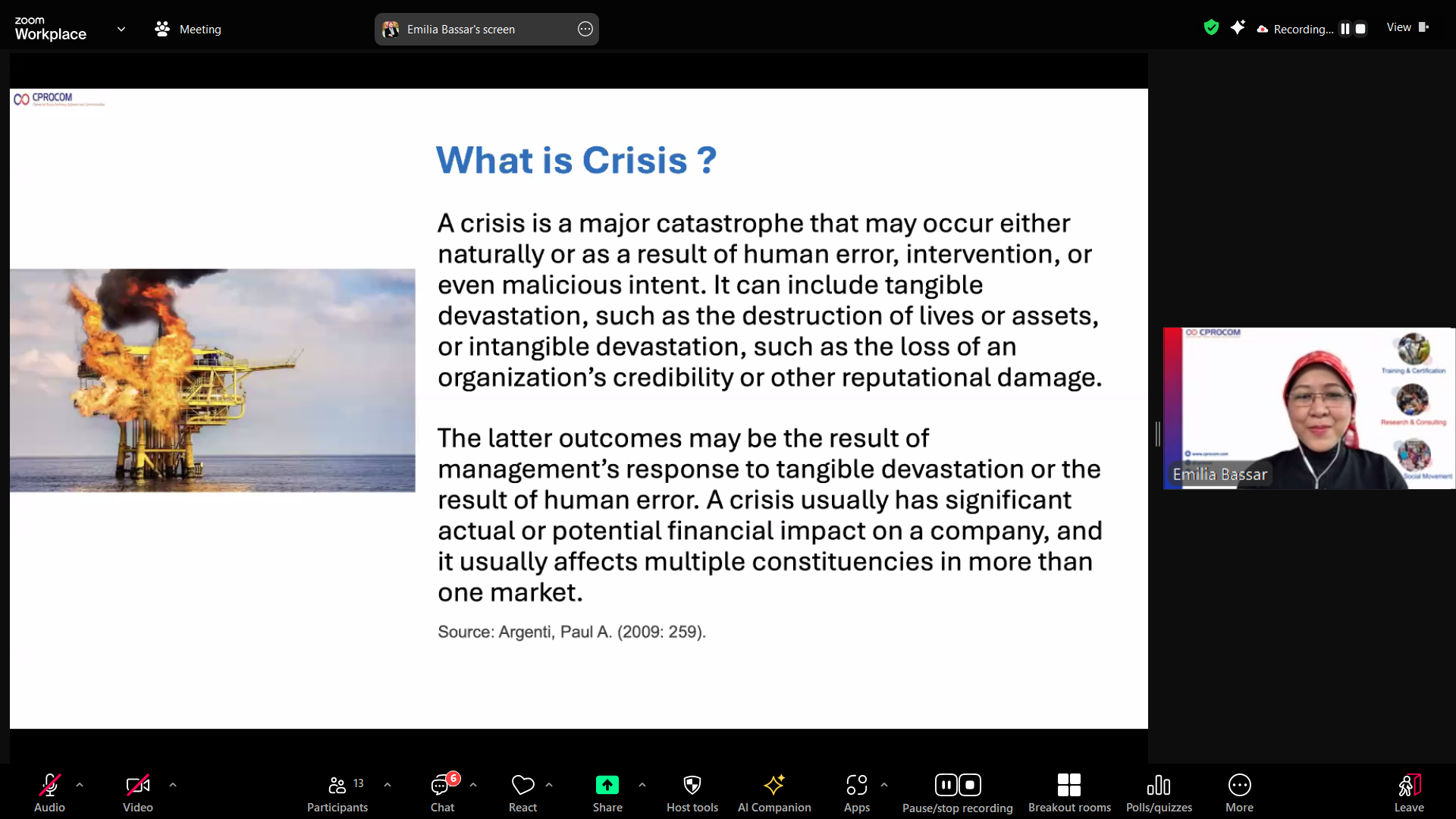
NAVIGATING THE UNCERTAINTY WITH CRISIS COMMUNICATION
NAVIGATING THE UNCERTAINTY WITH CRISIS COMMUNICATION
On 21 September 2024, CPROCOM held SaBar (Saling Belajar) Forum; a free webinar
designed to be a learning forum with experts, to discuss and to enhance one’s
knowledge about communication and sustainability. Every month, SaBar discuss a
new topic. September’s forum’s main topic is crisis communication and is roles
in maintaining reputation and public trust.
What is Crisis Communication?
Crisis communication is a strategy that companies use
to address any challenging situation or interruption in business that
jeopardizes the firm's reputation or employee’s trust within the company. A crisis can strike out of the blue in
today's world, threatening the stability and image of institutions, companies,
and communities. To minimize the damage, it’s important to implement effective
crisis communication.
What to Do When Crisis Occurs?
Crises usually arise from unresolved issues or unexpected incidents such as natural disasters. In the forum, Dr. Emilia Bassar; key expert in PR and Crisis Communication stated that a company can implement pre-crisis communication strategies such as:
1) Gather a crisis communication
team to anticipate crises. Ideally, the board and senior management should lead
the communication team.
2) Media Spokesperson and
Handling: It is important to have a designated spokesperson for various crisis
levels. It’s important to be transparent in communicating with the
stakeholders, employees, and the public.
3) Train the spokesperson and
their team so they will be well prepared for when a crisis occurs. Having annual
drills of crisis simulation can be beneficial for the company’s long run.
4) Establish a crisis alert and
monitoring system to keep the company in the loop about crises happening within
the company. It helps to gather insights for future crisis prevention and
response. This also supports transparency in communications.
5) Identify target audiences to
ensure the company relay correct messages to the exact group of people. Always
remember that besides external stakeholders, employees are the company’s main driver
of crisis mitigation efforts.
6) Develop holding statements to
use during crises. These statements should be reviewed regularly until the
crisis is over.
What Happens After Crisis?
Crisis communication process doesn't end when the crisis is successfully resolved, it’s important to use the insights gained to refine the company’s crisis communication plan for future incidents. Here are some post-crisis communication strategies to be considered:
1) Assess the crisis
communication situation to determine an appropriate response when needed.
2) Adapt no more than 3 key
messages that the team has gathered about the crisis that will be relayed to
all stakeholders and target audiences.
3) Conduct a post-crisis
communication analysis for continuous development of the crisis communication
team and overall function of the company. This includes evaluating and
developing SOPs and communication strategies based on the crisis that has
occurred.
Another important tip after a crisis occurred or
post-crisis is finding out whether the crisis management is a success. One of
the keynote speakers; Lauda, stated “indicators of success include short-term
sentiment and long-term perception, as well as the importance of surveys to
measure public perception after a crisis. Feedback and criticism should not be
taken lightly after a crisis to ensure better prevention in the future.”.
To learn more about Crisis Communication, get an
in-depth insight with hands-on practice about crisis on CPROCOM’s Crisis
Communication and Media Handling training. Activities are held regularly as
scheduled on CPROCOM’s Linkedin (Center for Public Relations, Outreach, and
Communications) and Instagram (@CPROCOM). Get the chance to link with
participants by joining CPROCOM’s exclusive group to learn and network as well!
Don’t stop learning because as stated above, continuous development leads to
better function.
Leave a comment
Your e-mail address won't be published. Required fields are mark *

